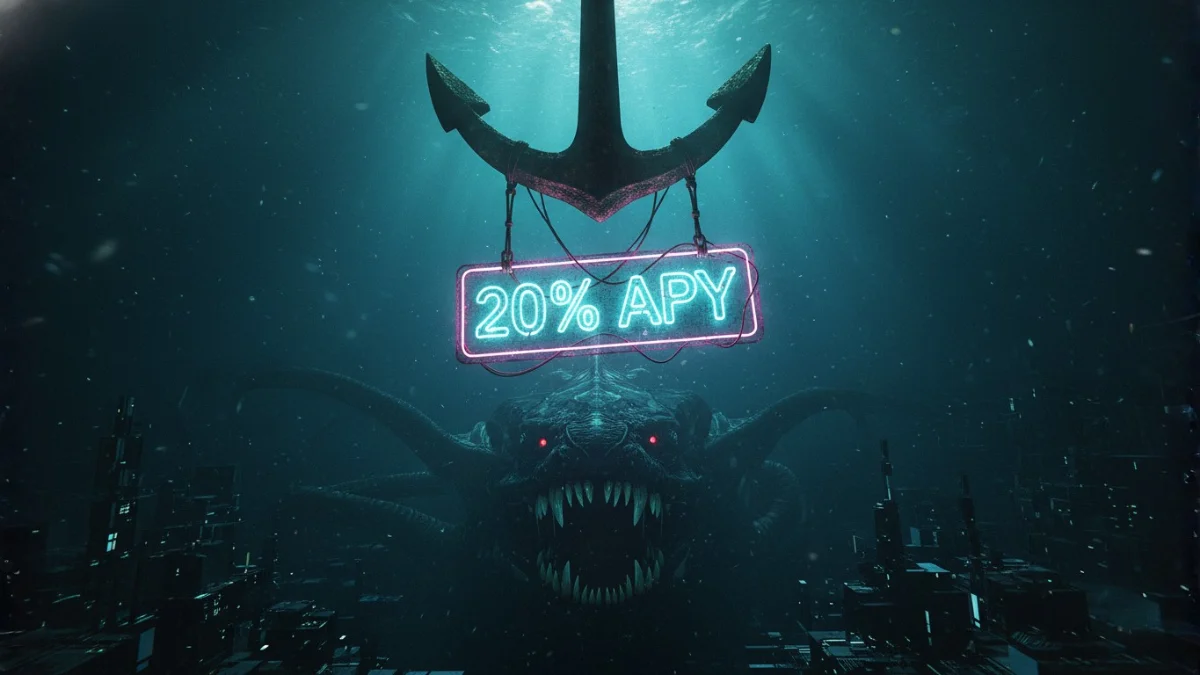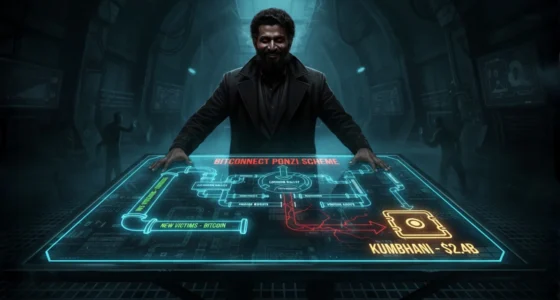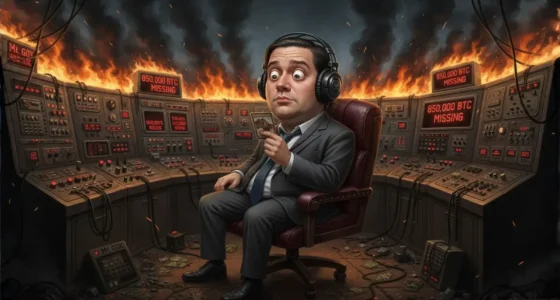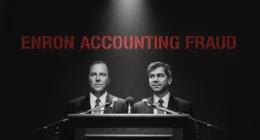The Algorithm That Ate $60 Billion
May 9, 2022. Monday morning. Michael Chen checked his crypto portfolio over coffee. His $400,000 in TerraUSD (UST) stablecoin was still worth $1.00 each. Safe. Stable. Earning 20% interest annually.
By Tuesday evening, his $400,000 was worth $50,000. Moreover, it was still falling. Furthermore, there was nothing he could do to stop it.
By Thursday morning, his entire investment was worth $127. Three hundred ninety-nine thousand, eight hundred seventy-three dollars had vanished. Additionally, the Luna tokens backing UST had crashed from $80 to $0.0001. Essentially worthless.
Across the world, this scene repeated millions of times. Retirees lost pensions. Young investors lost savings. Institutions lost billions. All in 72 hours.
This is the Luna collapse. A death spiral so violent, so complete, that it destroyed $60 billion faster than any financial disaster in history. Consequently, it exposed algorithmic stablecoins as a mathematical fraud. Meanwhile, its creator, Do Kwon, went into hiding.
Let’s investigate how confidence in code became the most expensive mistake in crypto.
The Promise: A Stablecoin Revolution
What Was Terra/Luna?
Terra was a blockchain created in 2018 by Do Kwon and Daniel Shin. The system had two tokens:
TerraUSD (UST): An algorithmic stablecoin supposedly worth $1.00 always. No bank reserves backing it. Instead, it maintained its peg through an algorithm tied to Luna.
Luna: The sister token that absorbed UST’s price volatility. When UST dropped below $1, the algorithm burned UST and minted Luna. When UST rose above $1, it burned Luna and minted UST.
In theory, this would keep UST stable at $1 forever. The math was supposedly perfect. Moreover, no centralized reserves were needed. Furthermore, it was “impossible” to break.
The 20% Interest: Anchor Protocol
Terra’s killer app was Anchor Protocol. This DeFi platform offered 20% annual interest on UST deposits. Real, sustainable 20% returns in a world where banks paid 0.5%.
Naturally, billions poured in. By early 2022, Anchor held over $14 billion in UST deposits. People mortgaged homes to get that 20%. Retirees moved pensions into it. Institutions allocated funds. The promise was irresistible.
But here’s the secret: The 20% wasn’t sustainable. Anchor was hemorrhaging money. Luna Foundation Guard (LFG), controlled by Do Kwon, was subsidizing the high rates. They were burning through reserves to maintain the illusion.
It was a Ponzi dynamic. New deposits funded old withdrawals. Eventually, mathematics would catch up.

Do Kwon: The Arrogant Founder
Do Kwon became crypto’s most controversial figure. A South Korean entrepreneur with Stanford credentials, he exuded confidence that bordered on hubris.
His Twitter presence was legendary—and disastrous:
- Mocked skeptics as “poor” and “idiots”
- Called critics “deranged” when they questioned the model
- Bragged that UST was “more stable than the dollar”
- Claimed Luna would “absorb all stablecoins”
When asked about Luna going to zero, he famously replied: “I don’t debate the poor.” This quote would haunt him.
Behind the swagger was dangerous certainty. Do Kwon genuinely believed his algorithm was perfect. Moreover, he convinced millions of others. Consequently, when critics warned about risks, he dismissed them viciously.
This arrogance would prove catastrophic.
The Growth Explosion (2021-Early 2022)
Terra ecosystem exploded in value:
January 2021: Luna = $1, UST supply = $1 billion
April 2021: Luna = $20, UST supply = $5 billion
December 2021: Luna = $80, UST supply = $12 billion
April 2022: Luna = $116 (peak), UST supply = $18.7 billion
Total Terra ecosystem value hit $60 billion. Luna became a top-10 cryptocurrency. Major VCs invested: Jump Crypto, Three Arrows Capital, Pantera Capital. Everyone believed in the algorithm.
But beneath the growth, cracks were forming.
The Hidden Vulnerabilities
The Death Spiral Mechanics
Terra/Luna had a fatal design flaw. The system worked perfectly during growth. However, during stress, it created a death spiral:
Normal Operation:
- UST drops to $0.98
- Users burn UST, mint Luna at $1 value
- They sell Luna for $0.98
- Arbitrage profit: $0.02
- UST supply decreases, price returns to $1
Death Spiral:
- UST drops to $0.95 (major depeg)
- Users panic, mass redemptions start
- Algorithm mints billions of Luna to keep UST at $1
- Luna supply explodes, price crashes
- Luna crashes further, UST depeg worsens
- More Luna minted, accelerating the crash
- Positive feedback loop to zero
The algorithm amplified panic instead of containing it. Moreover, there was no circuit breaker. Furthermore, the system assumed infinite demand for Luna. Fatally flawed assumptions.
The Anchor Problem
Anchor’s 20% rate was mathematically unsustainable. By late 2021, Do Kwon knew this. Internal documents later revealed:
- Anchor was losing $10-20 million weekly
- LFG was injecting funds to maintain rates
- No sustainable business model existed
- The entire system depended on continued growth
But Do Kwon kept promoting 20% returns. He raised billions from VCs claiming sustainability. Moreover, he expanded Anchor aggressively. Meanwhile, the hole grew deeper.
This was the fuse. Anchor’s inevitable failure would trigger everything.
The Missing Bitcoin Reserve
In March 2022, Luna Foundation Guard announced a plan: Buy $10 billion in Bitcoin as UST reserves. This would provide “backing” during stress.
They bought $3 billion in Bitcoin. However:
It wasn’t truly backing UST.
It wouldn’t stop the algorithm.
$3 billion couldn’t support $18 billion UST.
It gave false confidence.
The Bitcoin reserve was security theater. Nevertheless, it convinced people that Terra was safe. In reality, it just gave Do Kwon more time.

The Collapse: 72 Hours of Destruction
May 7-8: The First Tremors
Saturday, May 7. Large UST holders began selling on Curve Finance, a decentralized exchange. UST dropped to $0.98. Initially, this seemed normal—slight depegs happened before.
But the selling continued. Moreover, it accelerated. Furthermore, Anchor withdrawals increased. Smart money was exiting.
By Sunday, UST hit $0.95. The algorithm minted billions in Luna to restore the peg. Luna’s supply increased 20% in 24 hours. Consequently, Luna’s price dropped 15%.
The death spiral was beginning.
May 9: Monday—Panic Starts
Markets opened to chaos. UST dropped to $0.91. Meanwhile, Luna crashed to $60 (-25% from peak). Additionally, Anchor saw $2 billion in withdrawals.
Do Kwon tried to calm fears. He tweeted: “Deploying more capital—steady lads.” LFG was allegedly buying UST and selling Bitcoin to stabilize the peg.
But the selling overwhelmed them. For every dollar LFG spent, $10 was withdrawing from Anchor. The algorithm couldn’t handle the velocity. Moreover, Luna was crashing, making the algorithm less effective.
By Monday evening:
- UST: $0.68
- Luna: $35 (-70% from peak)
- $5 billion withdrawn from Anchor
People who woke up Monday morning wealthy went to bed that night watching their portfolios evaporate. Moreover, the worst was yet to come[10].
May 10: Tuesday—The Death Spiral
Tuesday morning brought complete chaos. Asian markets opened to catastrophe:
6:00 AM UTC: UST = $0.50, Luna = $15
9:00 AM UTC: UST = $0.30, Luna = $5
12:00 PM UTC: UST = $0.20, Luna = $1
3:00 PM UTC: UST = $0.15, Luna = $0.20
6:00 PM UTC: UST = $0.10, Luna = $0.05
The algorithm was minting trillions of Luna trying to restore UST. Luna’s supply exploded from 350 million to over 6 trillion tokens. This hyperinflation destroyed Luna’s value completely.
Meanwhile, exchanges were crashing from volume. Binance halted Luna trading temporarily. Coinbase suspended UST transactions. Everything was breaking.
Victims described watching their portfolios decrease in real-time:
“I lost $50,000 in 6 hours.”
“My retirement disappeared before lunch.”
“I kept buying the dip—it never stopped dipping.”
Do Kwon went silent. No tweets. No updates. LFG’s Bitcoin reserves had been sold. The algorithm was running on autopilot toward zero. Nobody could stop it.
May 11: Wednesday—Complete Annihilation
Wednesday brought the final destruction:
Morning: Luna hit $0.0001. UST traded at $0.08. Terra blockchain was halted—the network couldn’t handle the transaction volume.
Afternoon: Luna briefly rebounded to $0.001 on speculation of rescue plans. Then it crashed again.
Evening: Exchanges began delisting Luna and UST. The tokens were essentially worthless.
Final numbers from the 72-hour massacre:
- UST: $18.7 billion → $0.1 billion (99.5% destroyed)
- Luna: $41 billion → $0.0005 billion (99.999% destroyed)
- Total destroyed: $60 billion
- Victims: ~2 million people
Three days. $60 billion gone. Fastest wealth destruction in financial history.

The Casualties
Retail Investors
Ordinary people lost everything:
James Rodriguez, 35, Teacher: Invested $180,000 (entire life savings + loan) into Anchor for 20% returns. Lost 99.9%. Kept $180. Now faces bankruptcy and $80,000 debt.
Susan Park, 58, Nurse: Moved $220,000 retirement fund into UST. “The 20% was supposed to fund my retirement. Now I have to work until I’m 70.”
Chen Wei, 28, Software Engineer: Lost $95,000 saved for house down payment. “I believed Do Kwon. I believed the algorithm. I was an idiot.”
Thousands of similar stories. Mortgages. Student loans. Retirement funds. All vaporized. Moreover, many victims borrowed money to invest, leaving them in massive debt with nothing to show.
Institutional Victims
Major institutions imploded alongside Luna:
Three Arrows Capital (3AC): Hedge fund held $200+ million in Luna. The collapse triggered their bankruptcy. Subsequently, they owed creditors $3.5 billion. Founders disappeared.
Celsius Network: Held significant Luna positions. The losses contributed to their bankruptcy weeks later. 1.7 million users lost access to funds.
Jump Crypto: Lost over $100 million on Luna investments. Additionally, they’d actively promoted Terra. Reputational damage was severe.
Even professional investors, supposedly sophisticated, got wrecked. The Luna collapse exposed how groupthink and FOMO infected institutional capital.
DeFi Ecosystem Collapse
Luna’s death spread contagion throughout crypto:
Immediate Cascade:
Bitcoin dropped 30% in two weeks.
Ethereum fell 40%.
The total crypto market lost $800 billion.
Multiple exchanges faced liquidity crises.
Secondary Failures:
- Three Arrows Capital is bankrupt
- Celsius bankrupt
- Voyager Digital bankrupt
- BlockFi nearly collapsed
Luna was the first domino. Its fall triggered a chain reaction, destroying dozens of companies and platforms. The entire 2021-2022 crypto bull market reversed violently.

The Investigation: Do Kwon’s Downfall
South Korean Prosecutors (June 2022)
Within weeks of the collapse, South Korean prosecutors launched a criminal investigation. They froze Do Kwon’s assets. Moreover, they issued travel bans. Additionally, they investigated Terraform Labs for fraud.
The charges focused on:
- Fraudulent claims about stability
- Misrepresentation of sustainability
- Market manipulation
- Violations of capital markets law
Do Kwon denied everything. Initially, he claimed Terra was a “decentralized protocol” and he bore no responsibility. However, evidence showed otherwise. He controlled everything. Moreover, he’d made the decisions that led to collapse.
U.S. SEC Investigation (September 2022)
The U.S. Securities and Exchange Commission charged Do Kwon and Terraform Labs with fraud. Specifically:
The Charges:
Unregistered securities offering (UST and Luna).
Fraudulent statements about stability.
Misleading investors about third-party validation.
False claims about mainstream adoption.
The SEC alleged Do Kwon orchestrated elaborate deceptions. For instance, he secretly arranged for Jump Crypto to restore UST’s peg in May 2021, then falsely claimed the algorithm had self-corrected.
Interpol Red Notice (September 2022)
As investigations intensified, Do Kwon disappeared. He claimed to be “not on the run” while refusing to reveal his location. Then, Interpol issued a Red Notice—an international arrest warrant.
Countries began searching. South Korea offered rewards. The U.S. requested extradition. Meanwhile, Do Kwon taunted authorities on Twitter. He posted photos of himself in unknown locations. Additionally, he claimed he’d done nothing wrong.
This arrogance would be his undoing.
The Arrest (March 2023)
Montenegro police arrested Do Kwon at Podgorica airport. He was using a forged Costa Rican passport. Moreover, he was attempting to board a private flight to Dubai.
The arrest was anticlimactic. The crypto kingpin who’d destroyed $60 billion was caught with fake documents trying to flee. No brilliant escape. Just pathetic desperation.
Both South Korea and the United States requested extradition. Legal battles began over which country would prosecute first. Meanwhile, Do Kwon sat in Montenegrin prison.

Extradition to U.S. (February 2024)
After months of legal wrangling, Montenegro extradited Do Kwon to the United States. He arrived in New York to face SEC charges and potential criminal prosecution.
The charges were severe:
- Securities fraud
- Wire fraud
- Conspiracy to defraud
- Market manipulation
Maximum potential sentence: 40+ years in prison. His trial is scheduled for 2025. Prosecutors have thousands of documents, messages, and testimonies proving deception.
The Luna 2.0 Debacle
The “Revival” Plan (May 2022)
Days after the collapse, Do Kwon proposed “Luna 2.0.” The plan:
- Create a new blockchain
- Airdrop new Luna tokens to victims
- Abandon UST completely
- “Start fresh”
Victims were furious. This wasn’t compensation—it was creating new tokens from nothing. Moreover, it did nothing for UST holders who’d lost everything. Furthermore, Do Kwon would still control the new chain.
Nevertheless, the Terra community voted to approve it. Desperation breeds bad decisions. People hoped something was better than nothing.
The Reality
Luna 2.0 launched in May 2022. Immediately, problems emerged:
Token Distribution:
- Pre-collapse Luna holders got most tokens
- UST holders got tiny amounts
- Do Kwon’s team retained significant control
- Many victims got nothing meaningful
Value Collapse: New Luna launched at $6. Within weeks, it crashed to $1.50. By late 2022, it traded at $1.20. The “revival” created minimal value.
Trust Destroyed: Why would anyone trust a Do Kwon project after Terra’s collapse? The answer: They didn’t. Luna 2.0 became a zombie chain with minimal activity.
The revival was a failure. It created false hope while delivering nothing substantial to victims.
The Deeper Fraud
The Fake Merchant Adoption
Investigations revealed Do Kwon had lied about Terra’s adoption. He claimed major companies used Terra for payments. Specifically, he cited Chai, a Korean payment app with “millions of users.”
The truth: Chai used Terra’s blockchain minimally. Moreover, transaction volumes were tiny. Furthermore, Chai users didn’t even know they were using Terra. Do Kwon had exaggerated wildly to create legitimacy.
The Market Manipulation
Evidence showed Do Kwon and Terraform Labs manipulated markets:
- Secretly coordinated large purchases to pump prices
- Arranged fake trading volume on exchanges
- Paid influencers to promote without disclosure
- Created sock puppet accounts praising Terra
Internal messages revealed the deception. Do Kwon knew the risks. Moreover, he knew the system was fragile. Nevertheless, he promoted aggressive growth to inflate valuations.
The VC Complicity
Major venture capital firms invested billions in Terra. Did they do due diligence? Evidence suggests no.
They saw:
- High growth numbers
- 20% yields
- Do Kwon’s confidence
- Peer firms investing
They didn’t ask:
- How is 20% sustainable?
- What happens during bank runs?
- Has anyone stress-tested the algorithm?
- What are failure modes?
Greed and FOMO replaced analysis. Consequently, VCs enabled the fraud through negligence. They chased returns without questioning fundamentals. Their reputations were destroyed alongside their investments.
Lessons from the Luna Collapse
The Stablecoin Lie
Luna exposed algorithmic stablecoins as fundamentally flawed. The concept:
- Maintain $1 peg through code
- No reserves needed
- Pure math and incentives
The reality:
- Confidence-based, not math-based
- Vulnerable to bank runs
- Death spirals are inherent
- Reserves are necessary
After Luna, regulators cracked down on algorithmic stablecoins. Multiple countries banned them. The entire category was discredited. Math alone cannot create stability.
The 20% Scam
If something offers 20% returns in a near-zero rate environment, it’s unsustainable. Period. Either:
- It’s a Ponzi scheme
- It’s taking an extreme risk
- It’s temporary and subsidized
- It’s fraudulent
Anchor was subsidized and unsustainable. Eventually, math caught up. The 20% was the bait. The collapse was inevitable.
Warning Signs Ignored
Every red flag was visible:
Arrogant Founder: Do Kwon’s Twitter behavior screamed danger. He attacked critics viciously. This is classic fraud behavior—deflect criticism through aggression.
Unsustainable Yields: 20% returns with no clear source. Basic financial literacy says this doesn’t exist.
Algorithmic Complexity: The Terra/Luna mechanism was intentionally complex. Complexity hides flaws. Simple systems are harder to scam.
Criticism Dismissed: Multiple economists warned about death spirals. Do Kwon called them “poor” and “stupid.” When founders can’t handle criticism, run.
No Audits: Terra’s algorithm wasn’t independently audited. No stress testing. No failure analysis. Just blind faith in code.
Regulatory Arbitrage: Based in Korea, operated globally, avoided U.S. oversight. Classic fraud geography.
Protection Strategies
How to avoid the next Luna:
1. Question Impossible Returns: If it promises exceptional returns, demand exceptional proof. 20% yields don’t exist without massive risk.
2. Understand What You’re Buying: If you can’t explain the mechanism to a child, don’t invest. Complexity is often intentional obfuscation.
3. Check Track Records: Luna had no real-world stress test history. It only existed during a bull market. How performs during a crisis matters most.
4. Watch Founder Behavior: Arrogance, attacks on critics, cult of personality—all red flags. Legitimate founders welcome scrutiny.
5. Demand Reserves: Stablecoins need audited reserves. Full stop. Algorithmic backing is mathematical theater.
6. Size Your Bets: Never put life-changing money in experimental crypto. The upside doesn’t justify the existential risk.
Where They Are Now
Do Kwon: In U.S. custody awaiting trial. Faces decades in prison if convicted. Assets frozen. Reputation destroyed.
Terraform Labs: Bankrupt. Dissolved. Facing multiple lawsuits. Over $40 billion in claims filed.
Luna 2.0: Trading around $0.60. Essentially dead. Minimal activity or development.
Victims: Most recovered nothing. Lawsuits ongoing. Bankruptcy proceedings distributing pennies on the dollar. Many will never financially recover.
Crypto Industry: Permanently changed. Regulators cracked down. Algorithmic stablecoins are banned or restricted. The entire DeFi sector faced existential scrutiny.
VCs Who Invested: Wrote off losses. Reputations damaged. Some firms closed. The Luna collapse exposed venture capital’s groupthink problem.
The Final Warning
The Luna collapse destroyed $60 billion in 72 hours. But the real destruction was trust. Millions of people learned that:
- Code can fail catastrophically
- Math can be weaponized
- Confidence games work even in tech
- Founders will lie convincingly
- Institutions enable fraud
- Complexity hides danger
Do Kwon promised an algorithmic stablecoin that “couldn’t fail.” He mocked critics. He attracted billions. Moreover, he became crypto royalty. Everyone believed.
Then, in one weekend, the algorithm executed exactly as designed—right into a death spiral. The math worked. The outcome was catastrophic. Because the design was flawed from the start.
But here’s the truly horrifying part: Right now, other algorithmic projects are promising impossible things. Other founders are attacking critics. Other complex systems are accumulating billions in deposits.
The next Luna is probably already operating. Growing quietly. Accumulating risk. Waiting for the trigger that starts the death spiral.
Will you be holding when it begins?
Because the Luna collapse taught one brutal lesson: When everyone believes something is impossible to fail, that’s precisely when it will fail most spectacularly.
Do Kwon learned this in handcuffs. Two million victims learned it watching their life savings vanish.
Don’t learn it the same way.
Resources
[2] “Terraform Labs Co-Founder Do Kwon Arrested in Montenegro.”
[5]Terraform and Kwon to Pay $4.5 Billion Following Fraud Verdict
Related reading(suggested)
[1]FTX Bankruptcy: Sam Bankman-Fried’s $8 Billion Fraud Breakdown
[2]Nikola Motors Fraud: The $34 Billion Fake Hydrogen Truck Company
[3]Synthetic Meat Startups: The Billion-Dollar Dream Crashed









